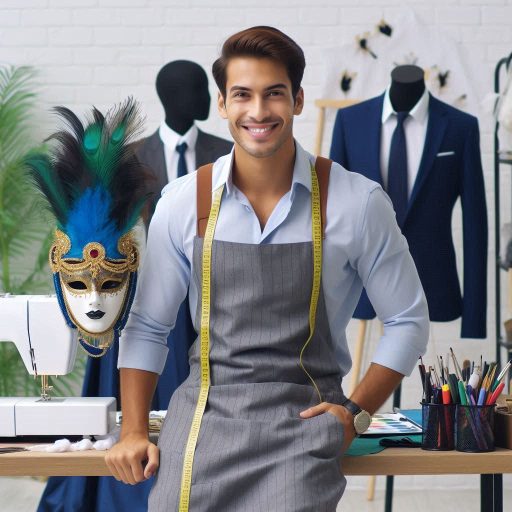Introduction
Historical accuracy in costume design plays a vital role in creating authentic film or theater productions.
Accurate costumes transport audiences to the specific time period, enhancing the overall storytelling.
Costume designers meticulously research historical details, ensuring clothing reflects the era‘s fashion, social norms, and culture.
This level of precision helps viewers connect with the story and characters on a deeper level.
Authentic costumes make characters feel real, reflecting their roles, status, and experiences.
Well-researched garments add layers to a character‘s identity, helping actors embody their roles more convincingly.
Costumes that stay true to history also help ground the setting, bringing visual coherence to the production.
When costume design is historically accurate, it immerses the audience in the past without distractions.
Small details, such as fabric choice or stitching methods, can significantly impact how believable the production feels.
Inaccurate costumes, on the other hand, can break the audience’s immersion and detract from the overall experience.
The dedication to historical accuracy elevates the professionalism and credibility of a production.
It shows respect for the period portrayed and adds depth to the narrative.
Accurate costumes not only enhance aesthetics but also contribute to the emotional and intellectual engagement of viewers.
Therefore, costume design‘s attention to historical details plays a crucial role in storytelling, enriching the entire production.
Historical Research
When it comes to costume design and historical accuracy, one of the most crucial aspects is conducting thorough historical research on the time period being depicted.
Let’s dive into the importance of this research and how it impacts the design of costumes.
Researching the historical context of the time period being portrayed is essential for costume designers to create authentic and accurate costumes.
It provides them with the necessary information to understand the clothing styles, fabrics, colors, and accessories that were prevalent during that era.
Historical accuracy plays a significant role in influencing the design of costumes.
It ensures that the costumes are not only visually appealing but also believable and true to the time period.
Transform Your Career Today
Unlock a personalized career strategy that drives real results. Get tailored advice and a roadmap designed just for you.
Start NowHere are some reasons why conducting thorough research is vital:
Understanding Clothing Trends
By delving into historical research, costume designers can gain insights into the clothing trends that were popular during the specific time period.
This knowledge helps them in accurately depicting the styles and silhouettes of that era.
Fabric and Material Choices
Historical research also guides costume designers in selecting appropriate fabrics and materials for creating costumes that are true to the period.
It allows them to choose textiles that were commonly used during that time, enhancing the authenticity of the costumes.
Color Palette and Accessories
Knowledge of the color palette and accessories prevalent in a particular era is crucial for achieving historical accuracy in costume design.
Researching these details enables designers to select colors and accessories that align with the historical period, enhancing the overall authenticity of the costumes.
Social and Cultural Influences
Understanding the social and cultural influences of the time period is essential for creating costumes that accurately reflect the norms and values of that era.
Historical research helps designers in incorporating these influences into their costume designs, making them more authentic and realistic.
Symbolism and Significance
Researching the symbolism and significance attached to clothing in a specific historical period allows costume designers to imbue their creations with deeper meaning and context.
This attention to detail enhances the storytelling aspect of the costumes and adds layers of authenticity to the overall design.
In essence, historical research is a fundamental aspect of costume design that cannot be overlooked.
It serves as the foundation for creating costumes that are not only visually stunning but also historically accurate.
By conducting thorough research, costume designers can breathe life into their designs and transport the audience into the world of the past with authenticity and precision.
Read: Learning from Costume Design Mistakes
Authentic Materials
When it comes to costume design and historical accuracy, using authentic materials is crucial for bringing the past to life.
Not only do authentic materials enhance the overall look of the costume, but they also provide valuable insight into the time period being depicted.
Significance of Using Authentic Materials
Authentic materials play a significant role in accurately portraying historical events and characters.
They help costume designers create costumes that are true to the time period, allowing the audience to immerse themselves in the story being told.
Showcase Your Business Today
Reach thousands of readers actively exploring professional services. Publish your business profile and grow your audience now.
Publish NowBy using authentic materials, costume designers can showcase the craftsmanship and attention to detail that went into clothing during a specific era.
This attention to detail adds another layer of authenticity to the overall production.
Examples of Historically Accurate Materials
- Silk: Silk was a luxurious fabric commonly used in the 18th century for garments worn by royalty and the upper class.
Its smooth texture and elegant drape made it a popular choice for formal attire. - Linen: Linen was a staple fabric in ancient Egypt and was used for a wide range of clothing, from everyday garments to ceremonial robes.
Its breathability and durability made it a practical choice for both commoners and nobility. - Wool: Wool has been used for centuries in various cultures for its warmth and versatility.
In medieval Europe, wool was a common fabric for outerwear, such as cloaks and tunics, due to its ability to provide insulation in cold climates. - Leather: Leather has been used throughout history for its durability and protective qualities.
In ancient Rome, leather was commonly used for armor and footwear, as well as accessories like belts and bags, due to its strength and resilience. - Velvet: Velvet was a luxurious fabric favored by royalty and the aristocracy during the Renaissance period.
Its soft texture and rich sheen made it a symbol of wealth and status, often used for elaborate gowns and doublets.
By incorporating these historically accurate materials into costume design, designers can create costumes that not only look authentic but also contribute to the overall storytelling of a production.
The use of these materials adds depth and texture to costumes, helping to transport the audience to a different time and place.
Overall, the significance of using authentic materials in costume design cannot be understated.
These materials not only enhance the visual appeal of costumes but also provide valuable insights into the historical context being portrayed.
By paying attention to details such as fabric choices, costume designers can create truly immersive and authentic experiences for audiences.
Read: Understanding Fabrics in Costume Design

Attention to Detail
When it comes to costume design and historical accuracy, attention to detail is paramount.
Every tiny element of a costume can contribute to the overall authenticity of a production.
Importance of Small Details
In costume design, small details such as trims, buttons, and stitching may seem insignificant, but they play a crucial role in creating a historically accurate look.
These details can transport the audience to a specific time period and enhance the overall visual appeal of the production.
Impact on Historical Accuracy
Small details have the power to elevate the historical accuracy of a production or detract from it if not executed correctly.
For example, using the wrong type of fabric or incorporating modern elements into a costume can disrupt the authenticity of the design.
Creating a Cohesive Look
Attention to small details helps costume designers create a cohesive and believable look for the characters in a production.
By focusing on the intricacies of each costume piece, designers can ensure that every aspect contributes to the overall historical accuracy of the costumes.
Building Character Authenticity
Small details in costumes play a significant role in building character authenticity.
Accessories, jewelry, and even the fit of a garment can provide valuable insights into a character’s background, social status, and personality, helping actors fully embody their roles.
Enhancing the Audience Experience
When small details are meticulously incorporated into costume design, they enhance the audience’s viewing experience.
Viewers are more likely to be immersed in the world of the production when every aspect of the costumes reflects the historical period being portrayed.
Research and Collaboration
Costume designers often conduct extensive research to ensure the accuracy of small details in their designs.
Collaboration with historians, costume experts, and production teams is essential to gather information and resources that will enhance the authenticity of the costumes.
Attention to Fabric and Texture
Choosing the right fabric and paying attention to texture are crucial aspects of designing historically accurate costumes.
Different time periods and social classes had distinct preferences for textiles, and incorporating these details can greatly impact the overall look of the costumes.
Exploration of Cultural Significance
Small details in costumes can also explore the cultural significance of specific garments, accessories, or embellishments.
By incorporating culturally relevant elements into costume design, designers can pay homage to historical traditions and customs, adding depth to the characters and the overall production.
Adherence to Period-specific Trends
Attention to small details allows costume designers to accurately capture the trends and fashion styles of a particular historical period.
From silhouette shapes to color palettes, understanding the nuances of fashion history is essential in creating costumes that align with the era being portrayed.
Revision and Refinement
Constant revision and refinement are key to perfecting small details in costume design.
From fittings to final adjustments, designers must meticulously review every aspect of a costume to ensure that it meets the historical accuracy standards set for the production.
In fact, paying attention to small details in costume design is not just about aesthetics; it is about honoring the historical authenticity of a production.
From fabrics to accessories, every element plays a crucial role in bringing characters to life and immersing the audience in a specific time period.
By prioritizing meticulous research, collaboration, and revision, costume designers can create visually stunning and historically accurate costumes that enhance the overall storytelling experience.
Read: Best Software for Digital Art: A Comprehensive Guide
Collaboration with Historians
When designing costumes for a historical production, collaborating with historians can provide numerous benefits.
Historians possess valuable knowledge about the time period, allowing for more accurate and authentic costume designs.
By working together, costume designers can ensure that the costumes are faithful to the historical context and help bring the production to life.
Benefits of collaborating with historians
- Accurate representation: Historians can provide insights into fashion trends, materials, and styles of a specific era, leading to more authentic costumes.
- Contextual understanding: Collaborating with historians helps costume designers better understand the social, cultural, and political influences that shaped clothing choices in the past.
- Detail-oriented approach: Historians can offer precise details about clothing construction, accessories, and embellishments that can enhance the overall historical accuracy of the costumes.
- Education and enrichment: Working with historians allows costume designers to expand their knowledge of historical fashion and develop a deeper appreciation for the significance of clothing in different time periods.
Successful collaborations between costume designers and historians
- “Hamilton” – Costume designer Paul Tazewell collaborated with historian Dr. Jennifer Morgan to ensure accuracy in depicting 18th-century attire for the characters.
- “The Crown” – Michele Clapton, the costume designer for the series, worked closely with royal historians to recreate Queen Elizabeth II’s iconic outfits with precision.
- “Outlander” – Terry Dresbach, the costume designer, collaborated with historical consultants and experts to authentically recreate 18th-century Scottish attire for the characters.
- “Mad Men” – Costume designer Janie Bryant consulted with historians to accurately capture the fashion trends of the 1960s, contributing to the show’s visual authenticity.
In short, collaborating with historians when designing costumes for historical productions is essential for achieving accuracy, authenticity, and overall visual impact.
Costume designers and historians collaborate to craft authentic costumes.
They enrich storytelling with historically accurate attire.
Showcase Your Business Today
Reach thousands of readers actively exploring professional services. Publish your business profile and grow your audience now.
Publish NowThis teamwork immerses audiences in historical settings.
Read: How to Balance Creativity and Practicality
Learn More: Game Designer vs. Game Developer: Key Differences
Cultural Sensitivity
When designing costumes from different time periods, it is crucial to be culturally sensitive.
Here’s why:
- Cultural sensitivity promotes respect for various traditions and practices.
- It helps avoid stereotypes and misrepresentations of different cultures.
- By being culturally sensitive, costume designers can accurately portray the diversity of historical eras.
Importance of Being Culturally Sensitive
One of the key reasons why cultural sensitivity is essential in costume design is to avoid cultural appropriation.
Designers can respect cultural significance by honoring traditional garments.
They create costumes that celebrate specific time periods.
By avoiding misappropriation, they show cultural sensitivity.
This approach ensures tradition is honored, not exploited.
Moreover, being culturally sensitive helps create an inclusive and authentic representation of historical periods.
It allows designers to showcase the richness and diversity of different cultures without resorting to stereotypes or caricatures.
Enhancing Authenticity through Cultural Accuracy
When costume designers prioritize cultural accuracy in their work, it significantly enhances the overall authenticity of a production.
Here’s how:
- Accurate costumes help transport audiences to a specific time and place, immersing them in the world of the story.
- Cultural accuracy demonstrates attention to detail and a commitment to portraying history faithfully.
- Costumes that reflect the cultural norms and values of a particular era add depth and context to the narrative.
Ultimately, cultural accuracy in costume design elevates the production by grounding it in a specific cultural context.
It shows a deep appreciation for the nuances and complexities of different societies, enhancing the audience’s understanding and enjoyment of the story.
Uncover the Details: The Average Salary of an Art Director in the USA
Balancing Artistic License with Historical Accuracy
Costume design plays a crucial role in bringing characters to life on stage or screen.
Designers face the challenge of balancing vision and historical accuracy.
They create costumes that both captivate and reflect the time period.
These designs must look stunning while staying true to history.
Balancing creativity with accuracy tests their skills in every project.
Challenges of Balancing Artistic Vision
- Artistic vision often involves creative liberties that may stray from historical accuracy.
- Designers may be tempted to prioritize aesthetics over authenticity in their designs.
- Pressure to create visually striking costumes can sometimes lead to inaccuracies.
Tips for Finding a Balance
- Research the historical period extensively to understand the fashion trends and clothing styles of the time.
- Consult historical sources such as paintings, photographs, and written records for accurate references.
- Consider the character’s background and social status when designing their costume to reflect their identity authentically.
- Incorporate subtle historical details into the costume to add authenticity without compromising artistic vision.
- Seek feedback from historians or experts in costume history to ensure accuracy in your designs.
- Experiment with different fabrics, textures, and colors to achieve a balance between creativity and authenticity.
In a nutshell, striking a balance between artistic license and historical accuracy is a delicate but essential aspect of costume design.
By following these tips, designers create captivating, authentic costumes.
They transport audiences visually and immerse them in the historical world.
Conclusion
It is evident that historical accuracy in costume design is crucial. Inaccurate costumes can detract from the authenticity
Costumes are not just outfits; they are essential in setting the tone and time period of a production.
Accurate costumes enhance the audience’s immersion into the story, making the production more memorable and impactful.
When choosing or designing costumes, it is crucial to research the historical context and ensure accuracy
Next time you watch a play or movie, pay attention to the costumes and appreciate the effort put into historical accuracy.
Costume design is an art form that plays a significant role in bringing a story to life. Historical accuracy is key to achieving this.
[E-Books for Sale]
The Big Book of 500 High-Paying Jobs in America: Unlock Your Earning Potential
$19.99 • 500 High-Paying Jobs • 330 pages
Explore 500 high-paying jobs in America and learn how to boost your career, earn more, and achieve success!
See All 500 High-Paying Jobs of this E-Book
1001 Professions Without a Degree: High-Paying American Jobs You Can Start Now
$19.99 • 1001 Professions Without a Degree • 174 pages
Discover 1001 high-paying jobs without a degree! Unlock career tips, skills, and success strategies for just $19.99!




